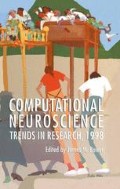Abstract
We investigate what computational mechanisms give rise to the nonlinearity of the complex cell receptive field in the primary visual cortex. Complex cells are characterized by their nonlinear spatial properties such as spatial phase invariance and nonlinear response to multiple bar presentations. We carry out network simulations to estimate the second-order Wiener-like kernels for several different models. Models with nonlinear spatial pooling of simple-cell-like linear subunits reproduce the second-order kernels in good agreement with physiologically estimated kernels, while models without the pooling mechanism fail to reproduce the kernel. The structure of the kernels is independent of specific nonlinear transfer functions such as half-wave rectification and squaring. The results support the cascade mechanism consisting of simple cells’ local feature extraction followed by nonlinear spatial pooling.
Access this chapter
Tax calculation will be finalised at checkout
Purchases are for personal use only
Preview
Unable to display preview. Download preview PDF.
References
R. C. Emerson, M. C. Citron, W. J. Vaughn, and S. A. Klein, J. Neurophysiology, 58, 33–65, (1987)
R. G. Szulborski and L. A. Palmer, Vision Research, 30, 249–254, (1990)
J. R. Bergen and E. H. Adelson, Nature, 333, 363–364, (1988)
K. Sakai and L. H. Finkel, J. Optical Society of America, A, 12(6), 1208–1224, (1995)
B. W. Mell, D. L. Rudermen, and K. A. Archie, Advances in Neural Information Processing Systems 9, (Ed.) M. C. Mozer, et. al., 83–89, MIT Press, Cambridge, MA (1997)
R. C. Emerson, M. J. Korenberg, and M. C. Citron, Biological Cybernetics, 66, 291–300, (1992)
J.-M. Alonso and L. Martinez, Abstracts for Annual Meeting, Society for Neuroscience, 1668, (1997)
Author information
Authors and Affiliations
Editor information
Editors and Affiliations
Rights and permissions
Copyright information
© 1998 Springer Science+Business Media New York
About this chapter
Cite this chapter
Sakai, K., Tanaka, S. (1998). Computational Mechanisms Underlying the Second-Order Structure of Cortical Complex Cells. In: Bower, J.M. (eds) Computational Neuroscience. Springer, Boston, MA. https://doi.org/10.1007/978-1-4615-4831-7_42
Download citation
DOI: https://doi.org/10.1007/978-1-4615-4831-7_42
Publisher Name: Springer, Boston, MA
Print ISBN: 978-1-4613-7190-8
Online ISBN: 978-1-4615-4831-7
eBook Packages: Springer Book Archive

